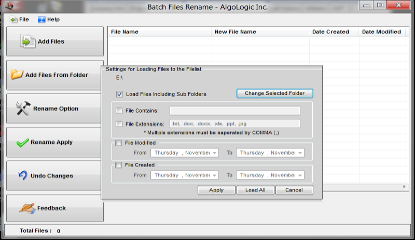
- RECURSIVE BATCH FILE RENAME HOW TO
- RECURSIVE BATCH FILE RENAME INSTALL
- RECURSIVE BATCH FILE RENAME WINDOWS
Now you want to rename all files that starts with letter "a" to "b". Let us say, you have the following files in your current directory.
RECURSIVE BATCH FILE RENAME INSTALL
To install mmv on Debian, Ubuntu, Linux Mint, and Pop OS, run the following command: $ sudo apt-get install mmv It is available in the default repositories of Debian-based systems. The mmv utility is used to move, copy, append and rename files in bulk using standard wildcards in Linux and Unix-like operating systems. I will keep updating the list if I come across any new method in future. As of writing this, I am aware of 8 different ways to batch rename files. There could be many commands and utilities to a bulk rename bunch of files. There are a few other utilities available to batch rename files in Linux. What would you do if you wanted to rename multiple files at a time? Worry not!

Until then, peace.But, the mv command won't support batch renaming files at once.

If you have any questions, send email to me at or post your questions on the Official Scripting Guys Forum. I invite you to follow me on Twitter and Facebook. Thanks again, Matt, for sharing your time and knowledge. I always enjoy helping fellow employees find ways to be more efficient and save time and money. Imagine how much “fun” it would be to rename all of these files manually or with some clunky old batch file. Cristofer said he will probably need to use these commands for renaming 1000+ files in the near future, and he will share this process with other members of his team.
RECURSIVE BATCH FILE RENAME WINDOWS
It is always fun to solve business challenges with Windows PowerShell commands.
RECURSIVE BATCH FILE RENAME HOW TO
I have never attempted this specific task, but by using Get-Command and Get-Help, we were able to find exactly how to do this in a couple of minutes. For example purposes, let’s say he needed to find all files with “current” in the name and replace “current” with “old”. He needed to find all files with a specific character string in the name and replace this character string with a new character string. His immediate need was to rename almost 250 files that are located in various folders on the file system.

I told him that I am sure Windows PowerShell can help-and that was before I even heard the question. He had a business need and he heard from someone that Windows PowerShell could help. I received a call from a gentleman named Cristofer this afternoon. Matt Tisdale is back today with another solution to a situation at work… Microsoft Scripting Guy, Ed Wilson, is here. Summary: Learn how to use Windows PowerShell to rename files in bulk.


 0 kommentar(er)
0 kommentar(er)
